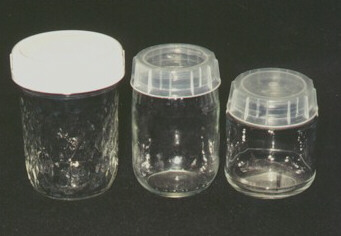Plant Tissue Culture of African Violet (Our "model
plant")
We use this as our model plant because it is readily available
in discount stores, responds well in tissue culture, and is a favorite
house plant.
Step 1: Prepare sterile water and medium
Supplies needed for one quart of medium (20 baby food jars) plus
sterile water:
- 1 quart jar
- 20 baby food jars (4 or 6 oz)
- 2 pint jars (regular opening)
- 20 plastic or metal baby food jar caps
- 2 pint jar plastic caps‚ or regular metal rings and lids if
using a pressure cooker (the white plastic caps will survive autoclaving
though they might get a little soft)
- long handled spoon
- pH paper
Sterile water will be needed to rinse plant pieces after
they are soaked in bleach solution. Fill pint jar 1/2 full with tap water
or distilled water. Place cap on loosely. Set aside until media preparation
is finished.
Sterile African violet medium is needed to grow the plant parts.
The following is combined in a quart jar: 1 packet MS medium, 2 tablespoons
table sugar, 1 mg BAP, 1 ml PPM, distilled water. Using pH paper, vinegar,
and baking soda, adjust the pH to about 5.5 to 6.0. Note that
hormones solutions can be purchased in concentrations of 1 mg/ml and measured
with a simple baby dropper hence you will not need an expensive balance
to weigh them.
Add 3 tablespoons of liquid medium to each baby food jar using a
plastic measuring tablespoon. Add one half level "pink Baskin-Robbins" spoon OR one level "pinch" spoon of agar to each baby food jar. Place polypropylene
baby food caps on the jars (if using a microwave) and press to tighten.
Polypropylene caps or the original metal caps can be used in a pressure
cooker.
Sterilization of water and media can be done with either a microwave
oven or a pressure cooker.
Step 2. Preparing a "clean
area"
The purpose of the clean area is to limit the number
of particles that fall into your tissue culture jar. These airborne particles
carry bacteria and fungi, and can kill your plant tissues because they
grow faster than the plants. A clean area can be made from a plastic-lined
cardboard box or a plastic storage box with a "window" cut out.
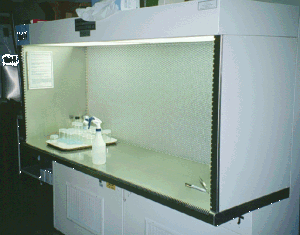
|
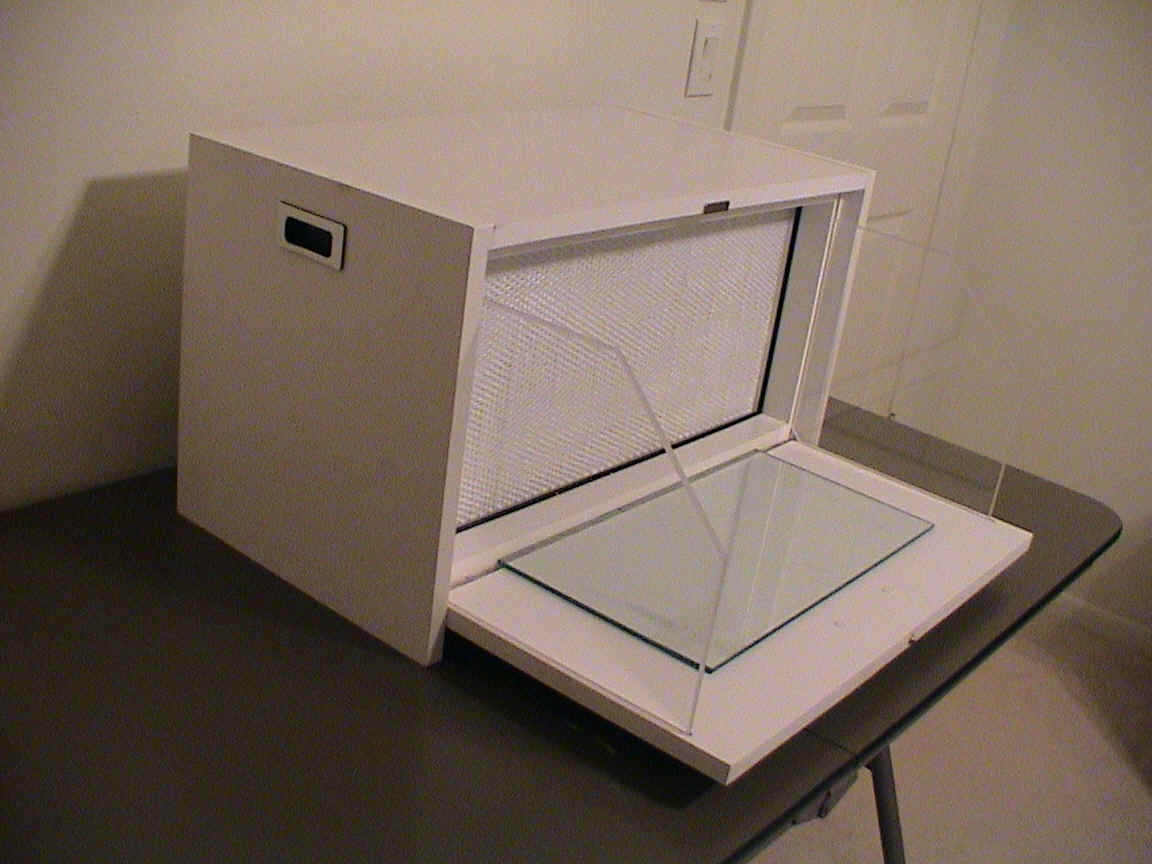
|
These are commercial
laminar flow hoods.
|
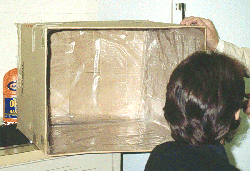
|
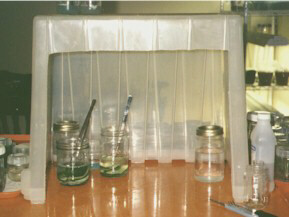
|
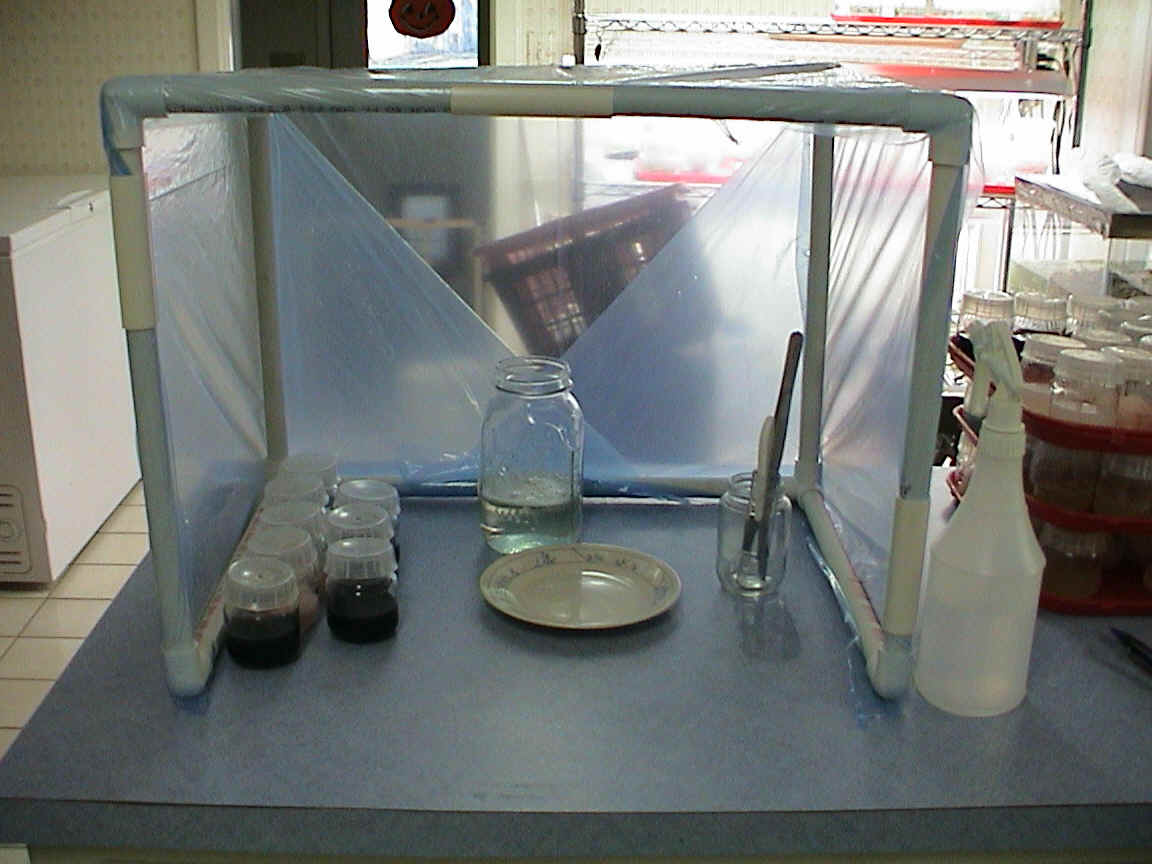
|
These are inexpensive
clean boxes.
|
The inside of the clean box and the surface of the clean
area should be wiped down, or sprayed, with 70% alcohol or a 10% bleach
solution. All items that are put into the clean area (media jars, bleach
container, sterile water jar, "dipping" alcohol) need to be wiped down,
or sprayed, to get rid of possible contaminants. Hands should be washed in
soap and water for at least 20 seconds, and then wiped with 70% alcohol.
Dip or soak instruments in 70% alcohol.
Step 3: Isolation and culture
of African violet leaves
Pick up a leaf with forceps and dip into the
70% alcohol for a few seconds. This will remove some debris and wax. Place
leaf in 10% bleach solution and allow to soak for 10 minutes. Stir occasionally.
Move the bottle with leaves to the clean box. Transfer leaves to sterile
water using the forceps, and allow to soak for 1-5 minutes.
Inside the clean box, wipe a small salad plate with 70% alcohol.
Note that you could also use a paper towel laid directly on the table surface;
spray it down with alcohol and you have a sterile surface. Dip the
forceps in 70% alcohol and transfer one leaf to the plate. Dip the kitchen
knife in 70% alcohol. Holding the petiole end of the leaf with the forceps,
cut the edges of the leaf away. Then cut the leaf into two pieces.
Loosen the caps on 2 baby food jars. Dip the forceps
in 70% alcohol. Pick up one leaf piece. With your other hand, pick up
the cover of the media jar and place the leaf piece in the jar. Quickly
replace the cover. Wrap florists’ tape or surgical tape around the outside
of the jar. This will help to minimize the debris that gets into the jar
and causes contamination of the cultures.
Put the cultures in a bright room out of direct sunlight
or set the cultures on shelves with cool-white fluorescent lights positioned
about 9-12 inches from the shelf below. Lights should be on 16 hours per
day. The leaves should start to swell in 2-4 weeks, and small bumps and
then leaves will appear on the "mother" leaf's surface.
The plant growth regulator, BAP induces shoots to grow from cells
in the leaf. Within 4-5 weeks, small plantlets will be visible on the
surface of the leaves.
Step 4: Transfer "plantlets" to fresh medium
The newly developing plantlets will grow better if they
are transferred to fresh medium without growth regulators. The growth
regulators can inhibit elongation of the shoots and the formation of roots.
After 4-6 weeks, make fresh medium using the "Home Style Medium" recipe below. Follow the same instructions as you did for the original
medium using these ingredients:
"Home Style Medium"
In a quart jar filled with water, mix:
1 teaspoon hydroponic fertilizer
(Peter’s NPK 20-20-20)
2 tablespoons sugar
a multivitamin pill
1 ml PPM
Mix well. The vitamin pill will not completely dissolve.
It can be removed after a couple of minutes. Test pH and adjust as you
did in the first batch of medium.
Measure 3 tablespoons medium into each baby food jar. Add two cotton
balls, or 1/2 teaspoon gelatin, or agar (as previously described). Cap
with polypropylene caps, or metal baby food jar caps if using a pressure
cooker. Sterilize as described earlier.
In the clean box, dip the forceps in 70% alcohol and carefully remove
the plant culture from it’s jar and place on the alcohol wiped plate.
Cut into sections or pull apart plantlets using sterile forceps and knife.
Place each small piece or plantlet into fresh medium. Recap and seal.
Step 5: Transfer rooted plantlets to soil
When plants have developed shoots and roots, they are ready for transfer
to sterile soil or soil less medium (found at your local discount store).
Gently remove the plants from the jar. Gloves should be worn when doing
this in case your skin is sensitive to the culture medium. Rinse off all
of the medium that is sticking to the stem and roots under lukewarm running
water. Plant the tissue cultured plantlet in the moist soil. Water with
a liquid fertilizer such as Peter’s or Miracle Gro.
Cover the pot with a plastic bag. A high humidity is necessary for
the plant until it hardens off and adjusts to the outside world. After
3-4 days, start opening the bag for a while, increasing the time each
day until the bag can be removed. Now you can treat your new plant like
any other normal plant purchased from a store or grown in your greenhouse.
References to items in this article
can be found at my website: www.kitchenculturekit.com
The poster that this article is based on is at: http://www.kitchenculturekit.com/sivbposter.htm.
Email me at
kck@turbonet.com with
your questions or suggestions for tropical plant tissue culture protocols
and I'll try to address them in the next issue ..........................
Carol
Helpful Resources
Dirr, Michael A., and Charles W. Heuser, Jr. 1987. The Reference
Manual of Woody Plant Propagation: From Seed to Tissue Culture. Varsity
Press, Inc. 239 p.
Kyte, Lydiane, and John Kleyn. 1996. Plants from Test Tubes: An Introduction
to Micropropagation (Third Edition). Timber Press, Inc. Portland, Oregon.
250 p.
Basic plant tissue culture information, resources, and listservs
are located at:
http://www.kitchenculturekit.com.
Resources from my Species webpage
|
Banana
|
Keith Benson's Banana Page http://www.geocities.com/RainForest/2011/MicropropBAN.html
|
|
Sherwood Exotics http://www.sherwood.exotics.btinternet.co.uk/
|
|
The Banana Tree http://www.banana-tree.com/
|
|
Banana Garden http://www.bananagarden.com
|
|
Banana seeds and information
http://www.quisqualis.com/quisopen.html
Rare banana photos:
http://www.quisqualis.com/rareban00.html
|
|
Morocco - banana trees, potato seed, paulownia
trees and date palm. http://www.cropdevelopment.org
|
|
INIBAP Technical Guidelines No.6, Appendix
1, p29. http://www.inibap.org/publications/publications_eng.htm
|
|
|
Bamboo
|
American Bamboo Society http://www.americanbamboo.org
|
|
http://www.inbar.int/publication/txt/INBAR_Technical_Report_No27.htm
|
|
John Woods
http://esi.athenstn.com/wwt/wwt.html
|
|
International Network for Bamboo and Rattan
http://www.inbar.int/
|
|
Equipment, Methods and Protocols for Tissue
culture
http://users.cwnet.com/three4al/bamboo/Technical.htm
|
|
Dr N. Barathi, Director, Growmore Biotech
Limited
41 B, Sipcot Phase II, Hosur, Tamil Nadu,
India 635 109 Phone +91 4344 560564
fax +91 4344 560560
E-Mail growmore@vsnl.com
http://www.growmorebiotech.com
|
|
|
Ferns
|
Micropropagation of Ferns (Platycerium
Ferns) http://www.geocities.com/RainForest/2011/MicropropSHF.html
|
|
|
Hibiscus
|
http://www.hibiscus.org
|
|
|
Hosta
|
Q and Z Nursery http://www.qandznursery.com/
|
|
Hosta Haven
|
|
http://www.gardensights.com/MissVitro/ |
|
http://www.HostaLibrary.org
|
|
http://www.shadyoaks.com/home.html
|
|
http://www.winterberryfarms.com/
|
|
BA induces shoot formation in hosta:
http://home.okstate.edu/Okstate/dasnr/hort/hortlahome.nsf/toc/cole4
|
|
Wessel Nursery
Virginia Beach, VA. 23464
jwessel@infi.net Fax 757-424-6435
http://www.hostatissueculture.com
|
|
Jim Anderson
Rowen Gardens and Winterberry Farms TC
http://RowenGardens.com
|
|
http://www.hosta.org
|
|
|
Palms/Cycads
|
http://www.teaket.com/
|
|
Morrison's Palms and Cycads http://www.cycadsandpalms.com/
|
|
Palmdat Website http://www.palmdat.com/
|
|
SAPAD for Palm Increase http://sapad.com.sa/
|
|
|
PawPaw
(Asimina sp.)
|
http://www.pawpaw.kysu.edu/webres4.html
|
Sugarapple
Atemoya
Annona sp.
|
Nair, S., P.K. Gupta, and A.F. Mascarenhas.
1984a. In vitro propagation of Annona hybrid (Annona squamosa L. x Annona
cherimola L.). Indian J. Hort. 41:160-165.
Nair, S., P.K. Gupta, M.V. Shirgurkar, and A.F. Mascarenhas. 1984b.
In vitro organogenesis from leaf explants of Annona squamosa Linn. Plant
Cell Tissue Organ Culture 3:29-40.
|
|
|
Pineapple
|
Pineapple in vitro-plants for sale
Doris Escalante descalante@bioca.unica.cu
|
|
|
Plumeria
|
http://www.ghgcorp.com/beyer/plumeria.htm
|
|
|
Tropical Plants
|
Tropica Tissue Culture Laboratory (Aquatic
Plants) http://www.tropica.dk/tiscul.htm
|
|
Tropical Plant Sources http://www.zoneten.com/index.htm
|
Information on the web comes and goes very quickly, if you discover a bad
link please advise us so we can update.
Happy culturing.............................
|
Carol
|
© MMIV - Volume 1 Number 3 Whole Number 3 Tropical Visions July 2004

